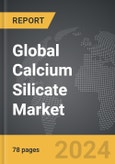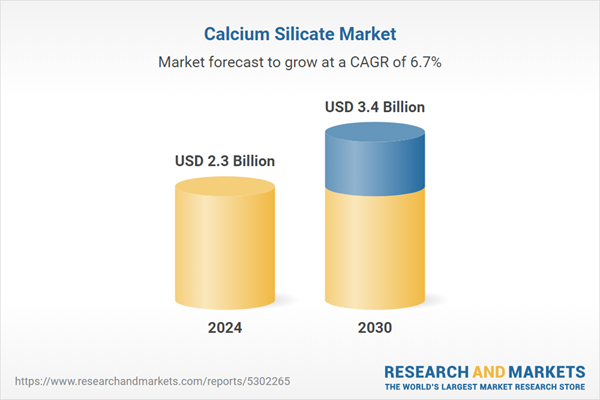The global market for Calcium Silicate was valued at USD 2.3 Billion in 2024 and is projected to reach USD 3.4 Billion by 2030, growing at a CAGR of 6.7% from 2024 to 2030. This comprehensive report provides an in-depth analysis of market trends, drivers, and forecasts, helping you make informed business decisions.
Global Calcium Silicate Market - Key Trends and Drivers Summarized
What Is Calcium Silicate and How Is It Produced?
Calcium silicate is an inorganic compound composed of calcium, silicon, and oxygen, often found in the form of a fine white powder or in block form. It is a widely used material in various industries, valued for its excellent thermal insulation, durability, and fire-resistant properties. The production of calcium silicate typically involves the reaction between calcium oxide (lime) and silica under high-temperature and high-pressure conditions, a process known as hydrothermal synthesis. The raw materials used in this reaction are usually sourced from natural minerals such as quartz or synthetic compounds derived from industrial by-products. During the synthesis, calcium silicate hydrates are formed, which can then be molded into different shapes, ranging from boards and blocks to specialized insulation materials. After the initial formation, the material is cured and sometimes treated with additives to enhance specific properties like mechanical strength or water resistance. The resulting product is lightweight yet strong, non-combustible, and highly resistant to moisture and chemical attack. These characteristics make calcium silicate a popular choice in a wide range of applications, from construction and industrial insulation to passive fire protection and even as a functional filler in the production of paints and coatings. Its versatility and safety profile have established calcium silicate as a key component in numerous high-performance building materials and industrial products.Why Is Calcium Silicate So Widely Used Across Different Industries?
The broad applicability of calcium silicate stems from its unique combination of thermal insulation, fire resistance, and structural integrity, making it a valuable material in industries such as construction, manufacturing, and energy. In the construction sector, calcium silicate boards and panels are commonly used for wall linings, partitions, and ceilings in both residential and commercial buildings. These boards are preferred for their ability to withstand high temperatures and prevent the spread of fire, making them an integral part of fire-rated construction assemblies. Additionally, calcium silicate is used as a thermal insulation material in power plants, refineries, and chemical processing facilities, where it is applied to pipework, boilers, and furnaces to minimize heat loss and protect against fire hazards. Its excellent thermal stability and low thermal conductivity enable it to maintain structural integrity even at temperatures exceeding 1,000°C, ensuring long-term performance in extreme environments. Beyond insulation and fireproofing, calcium silicate is utilized as a functional filler in the production of cement, ceramics, and refractories, where it enhances the strength and durability of these products. In the food industry, it is used as an anti-caking agent in powdered products like salt and spices, ensuring free-flowing consistency by absorbing moisture. The material's non-toxic nature and inertness also make it suitable for use in applications that require strict safety and hygiene standards. Furthermore, calcium silicate's porous structure and low density allow it to serve as a lightweight aggregate in concrete, contributing to energy-efficient building designs by reducing overall building mass and improving thermal insulation properties.What Recent Innovations Are Expanding the Use of Calcium Silicate?
Innovations in the production and application of calcium silicate are expanding its potential uses, particularly in the fields of sustainable construction, advanced insulation, and environmental protection. One of the major developments is the enhancement of calcium silicate-based materials with nano-additives and reinforcing fibers to improve mechanical strength, thermal conductivity, and resistance to mechanical impact. These modified calcium silicate composites are being used to create high-performance fire barriers, blast-resistant wall systems, and structural panels that offer superior protection in hazardous environments such as chemical plants and offshore platforms. Additionally, researchers are exploring the use of calcium silicate as a key component in the development of carbon-negative building materials. By incorporating calcium silicate into cement and concrete formulations, these materials can capture and sequester CO2 during the curing process, helping to offset carbon emissions from traditional cement production. Another significant innovation is the production of super-insulating calcium silicate aerogels, which have an extremely low thermal conductivity and are lightweight yet mechanically robust. These aerogels are being integrated into thermal insulation systems for high-efficiency buildings and industrial equipment, providing enhanced energy savings while maintaining a slim profile. The adoption of advanced manufacturing techniques, such as 3D printing and digital fabrication, is also enabling more precise shaping and customization of calcium silicate products, making it possible to produce complex geometries that were previously unattainable with conventional methods. In environmental engineering, calcium silicate is being explored for use in water purification and soil stabilization, where its chemical properties allow it to neutralize acidic soils and capture heavy metals and other contaminants.What Factors Are Propelling the Growth in the Calcium Silicate Market?
The growth in the calcium silicate market is driven by several factors, including the increasing demand for energy-efficient construction materials, the rising emphasis on fire safety, and the expanding use of sustainable building practices. One of the primary drivers is the growing adoption of calcium silicate-based insulation materials in industrial and commercial settings. As industries worldwide strive to reduce energy consumption and carbon footprints, the demand for effective thermal insulation solutions has surged, positioning calcium silicate as a preferred choice due to its low thermal conductivity, high durability, and non-combustibility. Additionally, stringent fire safety regulations in both developed and emerging markets are fueling the use of calcium silicate in fire-rated partitions, ceilings, and protective linings, particularly in high-risk environments such as oil and gas facilities and high-rise buildings. This trend is further supported by the increasing focus on passive fire protection systems, which rely on materials like calcium silicate to contain and prevent the spread of fire without relying on active suppression methods. Another growth driver is the rising popularity of green building materials. With the construction industry seeking ways to minimize environmental impact, calcium silicate's potential to be integrated into carbon-neutral and carbon-capturing building products is gaining attention. This aligns with global sustainability goals and building certifications such as LEED (Leadership in Energy and Environmental Design), which promote the use of materials that contribute to energy efficiency and low environmental impact. Moreover, the material's versatility and safety profile make it attractive for use in diverse applications beyond construction, including its role as a filler in paints and coatings, where it improves durability and resistance to moisture and chemicals. Technological advancements in production methods are also enhancing the quality and availability of calcium silicate products, reducing costs and enabling manufacturers to meet growing demand across different regions. Collectively, these factors are propelling the growth of the calcium silicate market, positioning it as a key material for modern industrial and construction needs.Report Scope
The report analyzes the Calcium Silicate market, presented in terms of market value (USD Thousand). The analysis covers the key segments and geographic regions outlined below.Segments
Application (Cement, Paint & Coating, Insulation, Ceramic, Other Applications).Geographic Regions/Countries
World; United States; Canada; Japan; China; Europe (France; Germany; Italy; United Kingdom; Spain; Russia; and Rest of Europe); Asia-Pacific (Australia; India; South Korea; and Rest of Asia-Pacific); Latin America (Argentina; Brazil; Mexico; and Rest of Latin America); Middle East (Iran; Israel; Saudi Arabia; United Arab Emirates; and Rest of Middle East); and Africa.Key Insights:
- Market Growth: Understand the significant growth trajectory of the Cement Application segment, which is expected to reach $1.3 Billion by 2030 with a CAGR of a 8%. The Paint & Coating Application segment is also set to grow at 6.7% CAGR over the analysis period.
- Regional Analysis: Gain insights into the U.S. market, valued at $599.9 Million in 2024, and China, forecasted to grow at an impressive 10% CAGR to reach $798.6 Million by 2030. Discover growth trends in other key regions, including Japan, Canada, Germany, and the Asia-Pacific.
Report Features:
- Comprehensive Market Data: Independent analysis of annual sales and market forecasts in USD from 2024 to 2030.
- In-Depth Regional Analysis: Detailed insights into key markets, including the U.S., China, Japan, Canada, Europe, Asia-Pacific, Latin America, Middle East, and Africa.
- Company Profiles: Coverage of major players such as American Elements, Chaitanya Chemicals, Industrial Insulation Group, LLC, Isolite Corporation, Promat and more.
- Complimentary Updates: Receive free report updates for one year to keep you informed of the latest market developments.
Why You Should Buy This Report:
- Detailed Market Analysis: Access a thorough analysis of the Global Calcium Silicate Market, covering all major geographic regions and market segments.
- Competitive Insights: Get an overview of the competitive landscape, including the market presence of major players across different geographies.
- Future Trends and Drivers: Understand the key trends and drivers shaping the future of the Global Calcium Silicate Market.
- Actionable Insights: Benefit from actionable insights that can help you identify new revenue opportunities and make strategic business decisions.
Key Questions Answered:
- How is the Global Calcium Silicate Market expected to evolve by 2030?
- What are the main drivers and restraints affecting the market?
- Which market segments will grow the most over the forecast period?
- How will market shares for different regions and segments change by 2030?
- Who are the leading players in the market, and what are their prospects?
Some of the 12 major companies featured in this Calcium Silicate market report include:
- American Elements
- Chaitanya Chemicals
- Industrial Insulation Group, LLC
- Isolite Corporation
- Promat
- Pyrotek
- Skamol A/S
- Thermal Ceramics
- Zircar
Table of Contents
I. METHODOLOGYII. EXECUTIVE SUMMARY2. FOCUS ON SELECT PLAYERSIII. MARKET ANALYSISSOUTH KOREAREST OF ASIA-PACIFICARGENTINABRAZILMEXICOREST OF LATIN AMERICAIRANISRAELSAUDI ARABIAUNITED ARAB EMIRATESREST OF MIDDLE EASTIV. COMPETITION
1. MARKET OVERVIEW
3. MARKET TRENDS & DRIVERS
4. GLOBAL MARKET PERSPECTIVE
UNITED STATES
CANADA
JAPAN
CHINA
EUROPE
FRANCE
GERMANY
ITALY
UNITED KINGDOM
SPAIN
RUSSIA
REST OF EUROPE
ASIA-PACIFIC
AUSTRALIA
INDIA
LATIN AMERICA
MIDDLE EAST
AFRICA
Companies Mentioned (Partial List)
A selection of companies mentioned in this report includes, but is not limited to:
- American Elements
- Chaitanya Chemicals
- Industrial Insulation Group, LLC
- Isolite Corporation
- Promat
- Pyrotek
- Skamol A/S
- Thermal Ceramics
- Zircar
Table Information
| Report Attribute | Details |
|---|---|
| No. of Pages | 78 |
| Published | April 2025 |
| Forecast Period | 2024 - 2030 |
| Estimated Market Value ( USD | $ 2.3 Billion |
| Forecasted Market Value ( USD | $ 3.4 Billion |
| Compound Annual Growth Rate | 6.7% |
| Regions Covered | Global |









